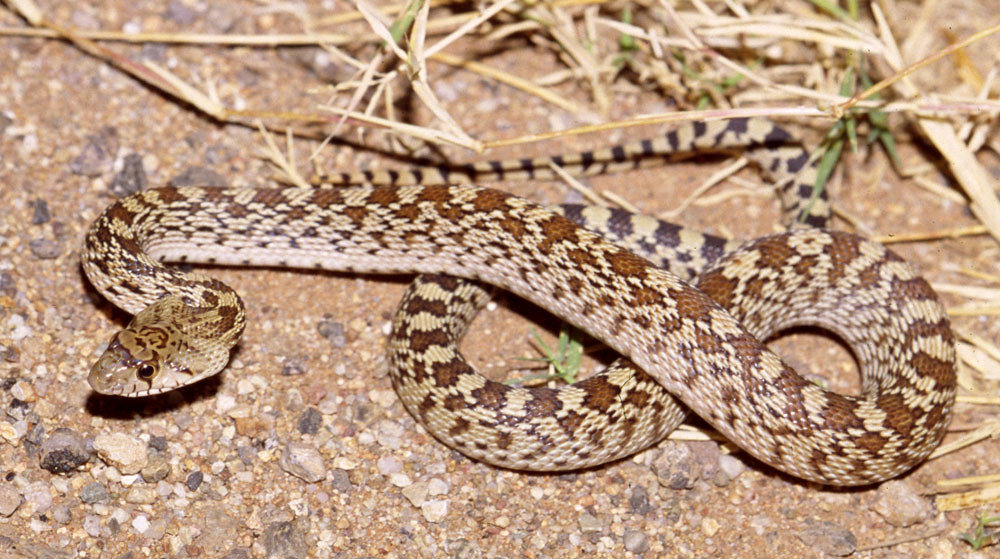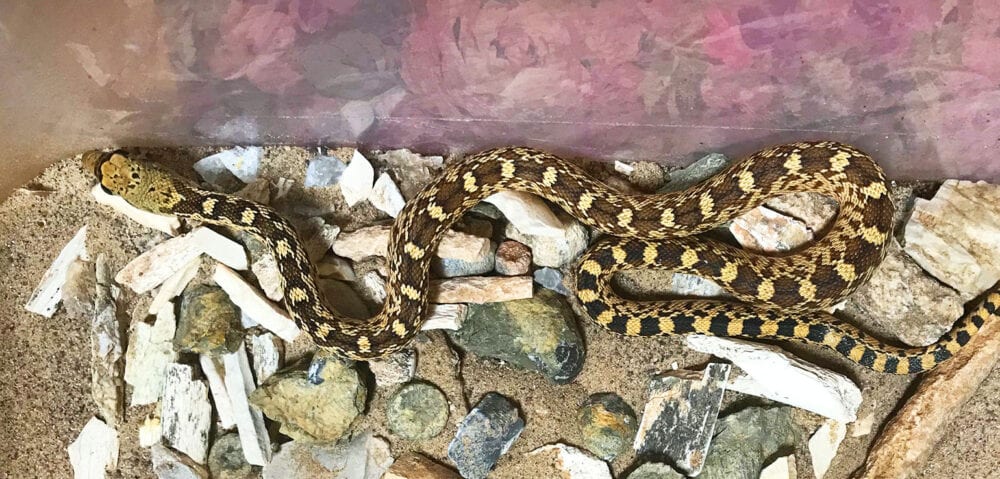
By Garth Tietjen
Making an Entrance
As the spring Sun rises in the East, it beats down on an eastern-facing rocky talus slope. This is not just any day on the Pajarito Plateau — it’s the day the sun will warm up this talus slope enough to awaken our story’s snake. She has been brumating under a few large rocks for five cramped months. Moving slowly, the snake slithers out from the rocks and stretches out in the sun to her full length of four feet.
This female Sonoran gopher snake (Pituophis catenifer affinis) is covered with dust when she leaves her hiding spot. Immediately, she is struck with hunger pains. She must eat and drink very soon or she won’t be strong enough to mate. Luckily, here on the Pajarito Plateau, there are many rodents to eat.
Jacobson’s Organ
There are two holes inside of her mouth, on the upper palate, called a Jacobson’s Organ. The snake places her tongue to these holes to receive taste and smell information. Within minutes, this Sonoran gopher snake has picked up the scent of a pack rat.
She uses her keen sense of smell to track the rat. As it moves, she picks up vibrations from the ground using the scales on her belly. She quickly locates the rat and eats it.
With all of this activity, she needs to quench her thirst. She crawls towards some athletic fields below that have just finished their watering schedule and drinks some of the water that has pooled on the grass. After this big adventure, she crawls back to her home.
Over the next few days, she continues to find meals of mice, rats, and a gopher. She starts to shed her skin.
Pheromone Trails
Our Sonoran gopher snake has found the food and water she needed after ending her brumation and is now ready to mate. As her skin sheds, she releases an invisible pheromone scent from her lower back.
This release of pheromones is like a detailed highway map to the location of the female snake. When a mature male snake finds this trail, he will follow it and find her. The pheromones that she lays down while moving around can last many days. She crawls around the perimeter of the rocky talus slopes and awaits her suitors.
Selective Mating
Many male snakes find our snake’s pheromone pathway to her lair, wanting to mate with her. She now takes center-stage and watches all the potential mates compete for this privilege.
These wrestling matches can go on for hours! Finally, the strongest male wins by endurance or strength. The female Sonoran gopher snake lifts her tail in approval, and the male then mates with her.
Developing Eggs
The female Sonoran gopher snake will lay eggs in about one month. In the meantime, she will need to feed regularly on rodents in order to develop healthy eggs. She will also must find a suitable place that’s not too wet and not too dry to deposit her eggs.

The Life Cycle Continues
After this mother-to-be finds a suitable secretive burrow, she drops nine leathery elliptical eggs that are about one-and-a-half by three inches in size, which will hatch in about 60 – 75 days. After she drops her eggs she will curl up around the clutch and stick around for a day or two before moving on. Whether the female stays for protection or just to rest is unclear. After she leaves, her eggs continue to absorb moisture and grow. The eggs of the female look like they are going to explode and start heavy sweating at 75 days.
Soon a tiny pin-like tooth comes out from within the egg, cutting multiple slits in the hard leathery shell. This tooth is on the end of the baby snake’s nose and will fall off in a day or two.
Then, the head of the magnificent baby Sonoran gopher snake pops out into a brave new world. And so goes the circle of life on the Pajarito Plateau.
